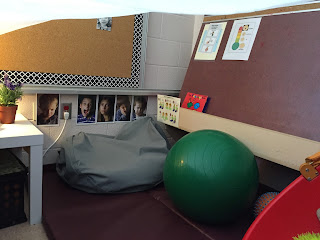 Many of you will have heard about Australia by now. Perhaps your child told you that they flew to Australia or that Mrs. Proud or Mrs. Piquette told him/her to go to Australia for a little while. Please don't be alarmed! Australia is a place that is safe and sound in our classroom.
Many of you will have heard about Australia by now. Perhaps your child told you that they flew to Australia or that Mrs. Proud or Mrs. Piquette told him/her to go to Australia for a little while. Please don't be alarmed! Australia is a place that is safe and sound in our classroom. The concept of Australia as a quiet spot where children can take a break, calm down, reflect on behaviour, or be alone for a moment comes from the book "Alexander and the Terrible, Horrible, No Good, Very Bad Day" by Judith Viorst.
 We read the book in class and found that a lot of our students could relate to Alexander and his bad day. After all, everyone has a bad day once in a while, where everything seems to be going wrong. In the book, Alexander is having such a horrible day, that he wishes he could just move to Australia. Hence, our area of the room for calming down and taking a break when things seem to be overwhelming or not going your way, is called Australia.
We read the book in class and found that a lot of our students could relate to Alexander and his bad day. After all, everyone has a bad day once in a while, where everything seems to be going wrong. In the book, Alexander is having such a horrible day, that he wishes he could just move to Australia. Hence, our area of the room for calming down and taking a break when things seem to be overwhelming or not going your way, is called Australia. Children can go to Australia, one at a time, if they need a break. They are able to set a time for 5 minutes, and take some time to cuddle a toy, lay down, stomp their feet, read a book, or use a TheraBall to help them. There are also a variety of visual aids in Australia to help children remember to breathe and reflect.
Children can go to Australia, one at a time, if they need a break. They are able to set a time for 5 minutes, and take some time to cuddle a toy, lay down, stomp their feet, read a book, or use a TheraBall to help them. There are also a variety of visual aids in Australia to help children remember to breathe and reflect.In class we are also going to be diving into problem-solving strategies. Mrs. Piquette and Mrs. Proud, along with the rest of the kindergarten team have been meeting regularly to discuss our students' urgent learning need. As a team, we have begun an inquiry project around how to help our children be better problem solvers.
Our inquiry question is very simple:
 What impact does teaching our students problem solving strategies have on their ability to solve problems independently?
What impact does teaching our students problem solving strategies have on their ability to solve problems independently? |
| As a class we generated a list of what problems at school might look like. What IS a problem? |

No comments:
Post a Comment